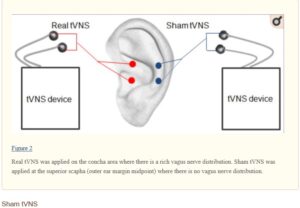Effects of transcutaneous auricular vagus nerve stimulation on the resting state of major depressive disorder
Kristen Sparrow • February 18, 2023

 This study investigated the mechanism underlying the immediate effect of transcutaneous auricular vagus nerve stimulation (taVNS) on major depressive disorder (MDD). The study involved 58 MDD patients and 54 healthy controls who underwent taVNS treatment. They were looking at which brain areas were affected. . Their findings suggest that taVNS has an immediate modulatory effect on the default mode network and cognitive control network, providing insights for the long-term treatment of MDD patients with taVNS. They used 20 hz, I use 15hz. I don’t think that’s key.
This study investigated the mechanism underlying the immediate effect of transcutaneous auricular vagus nerve stimulation (taVNS) on major depressive disorder (MDD). The study involved 58 MDD patients and 54 healthy controls who underwent taVNS treatment. They were looking at which brain areas were affected. . Their findings suggest that taVNS has an immediate modulatory effect on the default mode network and cognitive control network, providing insights for the long-term treatment of MDD patients with taVNS. They used 20 hz, I use 15hz. I don’t think that’s key.
I have posted about TAVNS a number of times and I am using it in the clinic in certain cases. One takeaway that I took, was that they do 30 minute treatments. I am considering making treatments longer when using TAVNS. With acupuncture alone, HRV starts declining after about 20 minutes. This has led me to believe that its work is done after about 20 minutes. But I’ve noticed with TAVNS, I see an improvement in the later segments of treatment. So perhaps I need to extend my protocol. Always something to try!
Abstract
Background: Previous studies have found that transcutaneous auricular vagus nerve stimulation (taVNS) is clinically effective in the treatment of major depressive disorder (MDD), and its efficacy mechanism is related to modulation of the default mode network (DMN) and cognitive control network (CCN). However, the mechanism of the immediate effect of taVNS for MDD remains to be elucidated.
Methods: A total of 58 patients with MDD and 54 healthy controls(HCs) were included in this study. The MDD group was treated with taVNS for 30 min (20 Hz, 4-6 mA) immediately, and we observed amplitude of low-frequency fluctuations (ALFF) abnormalities in the MDD group and changes in ALFF and functional connectivity (FC) before and after immediate treatment. The ALFF brain regions altered by taVNS induction were used as regions of interest to analyze whole-brain FC changes in the MDD group.
Results: After taVNS treatment, ALFF in the right precuneus was decreased in the MDD group. The FC of the right precuneus with the left middle frontal gyrus, the left posterior cingulate gyrus and the left angular gyrus were decreased in the MDD group. Correlation analysis showed that the FC values between the right precuneus and the left posterior cingulate gyrus in the pre-treatment MDD group was negatively correlated with the 17-item Hamilton depression rating scale scores.
Conclusion: TaVNS has an immediate modulatory effect on DMN and CCN. It would be proposed that these functional networks may be effective targets for the long-term treatment of MDD patients with taVNS.

